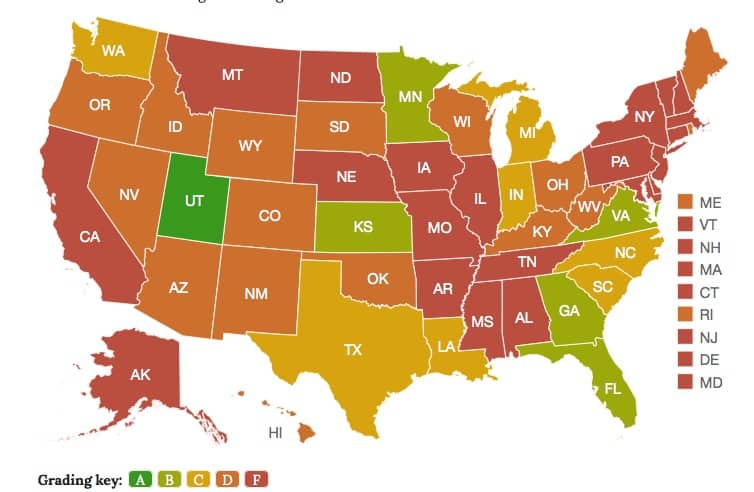Time to Modernize Education, Some States Leading the Way

“High-quality digital learning has the power to customize learning for each student’s unique needs, ensuring an education that is challenging, engaging, and relevant,” said Jeb Bush, former Florida governor and chairman of the Foundation for Excellence in Education (ExcelinEd).
Digital Learning Now! (DLN), an initiative of ExcelinEd, today released the 2012 Digital Learning Report Card, which measures each of the nation’s 50 states against the 10 Elements of High Quality Digital Learning.
DLN was formed in 2010 based on a core insight from Gov. Bush that state policy either accelerates or constrains K-12 progress and the scaling of next-generation models of learning.
The 2012 Report Card shows states are advancing personalized digital learning. Last year, more than 700 bills involving digital learning were considered and more than 152 were signed into law, with nearly every state enacting a bill that advanced a digital learning policy.
Examples include:
- Louisiana, Georgia and Utah are leading the way in adopting “course choice” programs that offer students the option to take publicly-funded, online courses from providers approved by the state.
- Massachusetts, Arizona and Iowa, among others, passed legislation designed to support competency-based models of education in which credit is awarded based on mastery instead of seat time.
- Maine, Utah and Alabama, are exploring new approaches to help schools provide Internet-enabled devices for all students.
Only six states – Utah, Florida, Georgia, Minnesota, Virginia, and Kansas – received an A or B, indicating that most states have work to do. DLN Executive Director John Bailey said, “The purpose of this report card is to highlight that progress, and provide states with policy examples for creating the conditions necessary to support high quality, next-generation models of learning.”
The 2012 report offers a comprehensive state-by-state analysis of laws and policies that embrace new models, utilize technology to meet the needs of all students and eliminate the barriers that inhibit innovation in K-12 education. It identifies opportunities for reform and highlights states that are making strides in offering high-quality digital learning options.
State policymakers are urged to advance bold reforms by:
- Using Digital Learning to Accelerate Education Reform: Make digital learning a priority and a means by which to accelerate state education reform.
- Making an Unwavering Commitment to Quality: Ensure every policy makes an unwavering commitment to quality as measured by improved student outcomes. Low-performing providers and schools should be shut down, and high-performing ones should be scaled.
- Expanding Course Choice: Establish more statewide course choice programs in which states approve a portfolio of high-quality courses from multiple providers. Like teacher reciprocity, states should consider entering into agreements to recognize the courses approved in other states that use a rigorous review and approval process.
- Expanding Student Eligibility: Ensure all students in the state are provided access to high-quality online courses.
- Reforming Funding Streams: Reform funding models, particularly for online learning, to award completion and success instead of simply attendance. Funding should reinforce quality and improved outcomes.
- Funding the Student: Fund the student instead of the system, so portions of the per-pupil funding follow the student to the course providers and schools serving them.
- Embracing Competency-based Education: End the archaic practice of seat time and establish a competency-based model that requires students demonstrate mastery of the material in order to earn credit.
- Creating Space for Innovation: Explore innovation waivers that allow schools to apply for regulatory relief around administrative, procurement, or instructional barriers.
- Accelerating the Shift to Digital Content: Expand the definitions of textbooks and instructional resources to allow flexibility in funding digital content, online resources and Internet-access devices. Use the process of evaluating instructional resource alignment to Common Core State Standards to accelerate the adoption of digital content and resources.
- Strengthening Data Collections: Improve the monitoring of implementation and outcomes through improved district surveys to better capture student enrollment and completion rates in online courses, student performance measures, blended learning implementation and adoption of competency-based models.
Oklahoma Superintendent Janet Barresi said, “Rural communities can use it to offer Advanced Placement and other honor classes to their students where otherwise they would not be able to afford a teacher for small classes. She pointed me to Howe High School in Southeastern Oklahoma as a digital learning leader.
“Digital learning, the future of education, maximizes achievement by allowing students to learn at their own time, place, path, or pace,” said Minnesota State Representative Pam Myhra. We recently featured 11 Twin Cities schools leading the way.
Robyn Bagley, Board Chair of Parents for Choice in Education (PCE), supported passage of Utah SB65, a groundbreaking choice to the course bill, and recently SB82, a student record bill based, in part, on a DLN SmartSeries paper on Data Backpacks. She said, “PCE appreciates the standards set by the report card and the challenge issued to meet the metrics for integrating technology and innovation into our schools in order to raise student achievement in Utah!”
For more, see:
- Digital Learning Now, December 2010
- Florida Poised to Retain Digital Learning Leadership, March, 2011
- John Bailey To Lead Digital Learning Now, June, 2012
- Utah Proves to be Innovative National Leader, March, 2012
- Utah Digital Learning Summit: Blending Learning, Penguins & Dopamine, October, 2012
Disclosure: Digital Learning Now! is a Getting Smart Advocacy Partner.







0 Comments
Leave a Comment
Your email address will not be published. All fields are required.